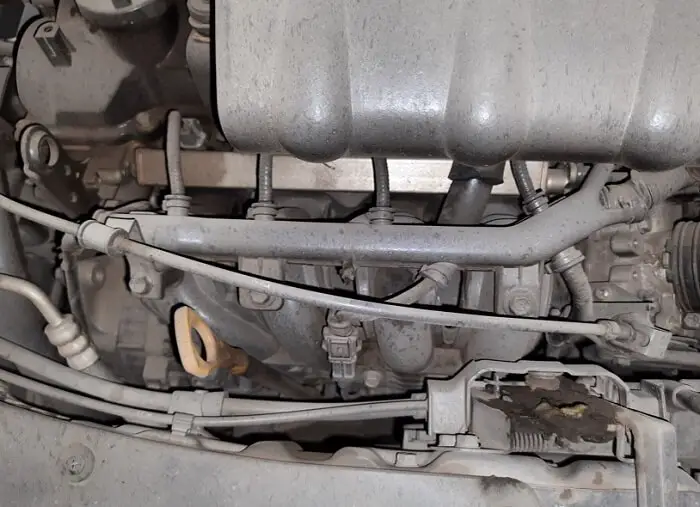Ever heard the phrase “changed thermostat now car won’t start?” If you are a car owner, I bet you have. And if you haven’t, yes, you should know that with a car thermostat, problems happen unexpectedly.
Usually, you begin to notice that your vehicle starts to overheat not long after you power up the engine, or the temperature gauge on your dashboard stays under its typical temperature point.
The next line of action is to replace the thermostat to solve the problem. Don’t you agree?
However, replacing the thermostat solves one problem, but could create another – the car refusing to start.
The issue of car won’t start after changing thermostat mainly occurs due to a disconnected thermostat housing ground wire, unintentional security system activation, dead battery, broken ignition wire, faulty spark plug, or it could be a damaged cylinder heads.
Have you changed thermostat and now car won’t start? Then you are at the right place. Here, you will get to know all possible causes and solutions to fix it. Stay tuned!
Table Of Contents
Changed Thermostat Now Car Won’t Start? 7 Causes!
A thermostat is an important element in the cooling system of an automobile.
The thermostat is like the keeper of the cooling system of the car’s engine, as it frequently monitors the temperature of the coolant and accurately regulates the coolant flow through the radiator by a spring mechanism to attain and conserve the optimum operating temperature for the car’s engine.
Without it, the car can overheat or cool down to extreme temperatures and may shut down or refuse to power up.
People also come across the situation where they have replaced radiator hose and then car won’t start.
Nothing about the replacement of the thermostat precisely would result in the engine not powering up and the same applies for radiator hose replacement as well.
So, when this occurs, try to retrace the steps you used to replace the thermostat to see if you have left something out.
The engine shall run even without the thermostat in its place. Chances are that the engine may overheat, but it may take some time before you start experiencing car starting problems.
There are a couple of scenarios that might cause the car not to power up after a thermostat change.
Having that in mind, it could be any of the following
Disconnected ground wire
When you are replacing the thermostat, you might have disconnected the temperature sensor ground wiring connection on thermostat housing. But it is possible that you forgot to reconnect it.
Forgetting to reconnect the thermostat housing ground wiring connection is one of the most frequent mistakes that one could do and ground connection shall be the first thing to check if you have already replaced the thermostat and the car is not starting.
If the ground connection is not available, then there will be circuit discontinuity and no temperature-sensing signal shall transfer to and from the thermostat.
If there is no coolant temperature sensing, your vehicle PCM may not allow the car to start since it will not send signals to radiator fan.
It is also possible that the wiring harness electrical terminals are either corroded or dirty and hence no ground or weak ground connection to the thermostat leading to a car starting problem.
Security system activation
Sometimes, it’s the security system of your automobile that deters your engine from turning on.
Ensure that you have not accidentally switched on any buttons which would trigger the kill switch of your vehicle.
You may notice visible indications or lights on your dash if something goes wrong.
If the immobilizer errs in recognizing your key due to kill switch activation then your car won’t power up after replacing thermostat and you may be thinking what is wrong with the thermostat?
Dead battery
Another possible cause is a dead battery. When the battery of the car is weak, it translates to the terminal voltage being too low for the electronics to function, and therefore the PCM won’t operate in sound minds, and when the mini-computers don’t operate soundly, everything runs haywire causing electrical gremlins from self-operating wipers to so much fuel being dumped into the car’s cylinders.
Broken ignition wire
Another possible cause for the car not starting after thermostat change or radiator rubber hose is a broken ignition wire that coincidentally might have got damaged when you change the thermostat while trying to power up the car.
It could be that the broken ignition wire has triggered the car’s security system and switched off the fuel pump and starter.
Faulty spark plug
The car not starting after replacing thermostat will not happen unless there is an issue with either fuel or spark ignition system.
Have you checked the condition of the spark plug? If not, it is time to do so.
The spark plug wiring harness connectors may be either corroded or dirty which would prevent the sparking of the plugs.
Often the parts which are on the verge of failing will fail especially the one related to the wiring harness.
Whenever some repair work is being done on adjacent parts you may unknowingly disturb and damage parts on which we are not supposed to do anything.
Fuel delivery problems
It might sound far-fetched but an empty fuel tank will not power up a vehicle, so endeavor to take a second look at your fuel gauge.
You may spray some starter fluid into the vehicle intake and see if the vehicle starts after cranking.
If it starts then, the car not starting can be related to a malfunction in any of the fuel delivery system parts like the fuel pump, fuel filter, or fuel injectors.
On the other hand, if the vehicle doesn’t start then you may rule out troubleshooting of fuel system parts.
Damaged cylinder heads
If you have driven your vehicle for a long time with a faulty thermostat, before you replace the thermostat with a fresh one, then there are chances that you might have overheated the engine to an extent that the vehicle cylinder heads would get warped.
A warped cylinder head would not allow proper compression of the fuel and would affect the engine operation adversely and the car won’t start.
You may need to do a compression test on all cylinders to confirm no issue.
A damaged gasket head would indicate after effects of engine overheating which may leak compressed and pressurized fuel via. the piston into the cooling system.
The fuel could also possibly wash away any oil assisting to shut the walls of the cylinder when you try to ignite the car, and therefore the car won’t start.
Car Won’t Start After Replacing Thermostat? 5 Solutions To Fix It!
There are a couple of suggestive solutions you can implement to start up your car if it refuses to power up after a thermostat change. Below are a few points that one shall check.
Ensure electrical connections
If you have changed thermostat and the car is not starting then ensure that you have reinstated the ground connection of the thermostat housing and all electrical terminals are free from rust and dirt. Replace the terminals, if they are almost weak and half broken.
A poor or no-ground connection would not allow the car to start even after replacing the faulty thermostat with a fresh one.
Care is to be taken to ensure firm contact of the electrical terminals with the thermostat.
Assess ignition system
The best technique to inspect the spark plug is to pull out the spark plug from its seating and hold the threaded part of the spark plug close to any of the engine casting parts to ground the spark plug.
Turn the ignition key ON while the spark plug touches the engine, and you shall be able to see the spark.
If you could see fire, then the ignition system and spark plugs are ok.
If there is no spark in the plug, then the car won’t start even after replacing thermostat and you need to replace the spark plugs as well.
Check car battery
If you loosened your battery you should inspect your cables and ensure that they are tight, perhaps it’s just a loose ground cable that would not allow the car to start. Fixing this should get you back on track.
Check the battery supply voltage, it shall be 12 V, if it seems to be less, charge it and confirm the voltage supply.
It is advisable that if your car is running on a battery about 5 years of age, change it instantly to prevent the computer problems that back you down at a tight corner with no evident exit in troubleshooting.
Test fuel pressure
To confirm that the issue is not due to the fuel delivery system, try hooking up a fuel pressure gauge to the test port on the rear of the intake, on the driver’s side.
Generally, the fuel pressure gauge is cheaper and you can get it at any part store.
It can be a really good tool to have in your toolbox, as it can come in handy.
If your car can produce up to 55 psi, your car shall start, Otherwise, you would need to replace the fuel pump.
Inspect car’s compression
If your car has refused to start perhaps due to flooding of fuel into the car’s cylinders, or much of the oil seal on the car’s cylinder has been washed away, this could result in a loss in compression and the car not starting up.
Remove all spark plugs from the engine and clean the dirt out of the spark plug socket.
Bolt a compression tester in the spark plug opening of each cylinder and start cranking the engine a few times.
The compression shall be more or less the same on all cylinders and the difference shall not be more than 15 lbs and the absolute valve shall be more than 100 lbs.
Therefore, endeavor to check if the compression is low and if it is, have it back on track by oiling the cylinders and powering up the car engine. Your car should be up and running in no time.
Final thoughts
Often the issue of the car not starting after replacing thermostat is nothing to do with the thermostat, but it can be related to adjacent parts including but not limited to a loose or corroded wiring harness connection, bad or dirty connectors of sensors without which the engine won’t start.
Ensure that you have plugged in all wiring connections and replaced corroded or broken terminals to bring your vehicle back on track.
There you have all you need to know about why your car isn’t starting up after a thermostat change.
The information provided in this article should be able to assist you in solving your car’s failure-to-start issue.
If after applying the suggestions above and your car still doesn’t start, it is recommended to visit a mechanic for detailed analysis.
Happy Motoring!
References
https://www.nissanforums.com/threads/replaced-thermostat-now-car-wont-start.112270/
Articles you may like to read
Does Your Ford F150 Radiator Fan Runs Constantly? 12 Probable Reasons And Solutions To Fix It!
Ford F150 Hard To Start When Hot? 9 Causes And Solutions to Fix It!
Radiator Hose Blew Off And Car Won’t Start? Reasons And Solutions To Fix It!
Car Won’t Start After Fuel Pump Replacement? All You Need To Know!
Car Won’t Start After Replacing Fuel Filter? 10 Causes And Solutions To Fix It!
Car Won’t Start After Replacing Crankshaft Position Sensor? 8 Reasons And Solutions To Fix It!

